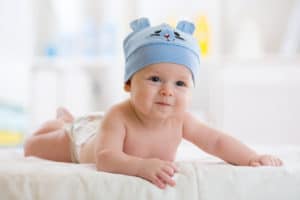As a developmental peculiarity, microcephaly describes a comparatively small head circumference in humans. As a rule, the developmental peculiarity is associated with intellectual disability, although the degree of disability is very individual.
In comparison, microcephaly occurs relatively frequently. 1.6 out of 1,000 children are affected. The Head Circumference Baby Table shows when microcephaly is diagnosed and provides the corresponding values.
The Head Circumference Baby Table is published by the WHO and contains both average values and normal deviations.
The causes of the handicap are very diverse and range from alcohol consumption during pregnancy to various chromosomal anomalies to rubella infection of the mother during pregnancy.
Table of contents
Microcephaly: A Malformation Of The Head
Not every small-looking head is associated with microcephaly. The decisive factor is the standard deviation. In principle, the condition is said to exist if the head is at least three standard deviations smaller than the mean in the respective age and sex group.
In addition, the general percentile in relation to body size must also be taken into account. Due to the too small head circumference, the affected people additionally suffer from a mental handicap, which is individually pronounced.
The decisive factors are the extent of the microcephaly and any accompanying symptoms.
The reasons for the defective head development can be brain malformations, such as microencephaly (brain that is too small) or dyscephaly (pathological deviation of the head shape).
In addition, premature closure of the cranial sutures is a possibility. In this context, one also speaks of a craniostenosis.
Detecting Microcephaly – Baby’s Head Circumference Provides Information
Regular measurements of the unborn child are already taken during prenatal diagnostics. Here, too, the head circumference is examined more closely.
If there are any abnormalities, further examinations follow.
During preventive examinations and directly after birth, pediatricians also measure newborns from head to toe.
The baby’s head circumference is not neglected in this process. Standard values that form an average are used for orientation. Deviations are generally possible and are taken into account accordingly.
However, if more than three standard deviations downward are observed, it may be a case of microcephaly.
Below you will find the values of the valid head circumference baby table, within the first months of life:
Part 1: Head Circumference Baby Chart For Boys
Head Circumference Newborn At 0 Months
On average 35.39 cm. Deviations downwards are possible up to a circumference of 32.93 cm.
Head Circumference Newborns At One Month
On average 38.12 cm. Downward deviations are possible up to a circumference of 36.4 cm.
Head Circumference Newborns At Two Months
On average 39.8 cm. Downward deviations are possible up to a circumference of 37.90 cm.
Head Circumference Newborns At Three Months
On average 41.23 cm. Downward deviations are possible up to a circumference of 39.5 cm.
Head Circumference Baby With Four Months
On average 42.09 cm. Downward deviations are possible up to a circumference of 40.17 cm.
Head Circumference Baby At Five Months
On average 42.94 cm. Downward deviations are possible up to a circumference of 40.97 cm.
Head Circumference Baby At Six Months
On average 43.74 cm. Downward deviations are possible up to a circumference of 41.72 cm.
Head Circumference Baby At Seven Months
On average 44.47 cm. Downward deviations are possible up to a circumference of 42.40 cm.
Head Circumference Baby At Eight Months
On average 45.10 cm. Downward deviations are possible up to a circumference of 42.99 cm.
Head Circumference Baby At Nine Months
On average 45.63 cm. Downward deviations are possible up to a circumference of 43.48 cm.
Head Circumference Baby At Ten Months
On average 46.7 cm. Downward deviations are possible up to a circumference of 43.89 cm.
Head Circumference Baby At Eleven Months
On average 46.44 cm. Downward deviations are possible up to a circumference of 44.23 cm.
Head Circumference Baby At Twelve Months
On average 46.77 cm. Downward deviations are possible up to a circumference of 44.54 cm.
A detailed head circumference baby table and size chart for the baby, which also goes beyond the first months of life, you can find, among other things, about the World Health Organization.
Part 2: Head Circumference Baby Table For Girls
Head Circumference Newborn At 0 Months
On average 34.74 cm. Downward deviations are possible up to a circumference of 32.32 cm.
Head Circumference Newborns With One Month
On average 37.10 cm. Downward deviations are possible up to a circumference of 34.94 cm.
Head Circumference Newborns With Two Months
On average 38.74 cm. Downward deviations are possible up to a circumference of 36.65 cm.
Head Circumference Newborns At Three Months
On average 39.84 cm. Downward deviations are possible up to a circumference of 37.85 cm.
Head Circumference Of Girls At Four Months
On average 40.74 cm. Downward deviations are possible up to a circumference of 38.71 cm.
Head Circumference Of Girls With Five Months
On average 41.62 cm. Downward deviations are possible up to a circumference of 39.54 cm.
Head Circumference Of Girls With Six Months
On average 42.44 cm. Downward deviations are possible up to a circumference of 40.32 cm.
Head Circumference Of Girls With Seven Months
Average 43.17 cm. Downward deviations are possible up to a circumference of 41.01 cm.
Head Circumference Girls With Eight Months
On average 43.80 cm. Downward deviations are possible up to a circumference of 41.61 cm.
Head Circumference Girls At Nine Months
On average 44.33 cm. Downward deviations are possible up to a circumference of 42.11 cm.
Head Circumference Girls At Ten Months
On average 44.77 cm. Downward deviations are possible up to a circumference of 42.53 cm.
Head Circumference Girls With Eleven Months
On average 45.14 cm. Downward deviations are possible up to a circumference of 42.88 cm.
Head Circumference Girls At Ttwelve Months
On average 45.47 cm. Downward deviations are possible up to a circumference of 43.18 cm.
Again, you can find a detailed size chart for the baby about WHO. In addition, we provide a head circumference baby table on our pages.
If the regular check-ups show that the circumference of your baby’s head is significantly below the range of the Head Circumference Baby Table, further examinations are absolutely necessary.
In most cases, microcephaly can be assumed. However, the head circumference alone is not necessarily decisive.
Premature babies, for example, sometimes have a much smaller circumference than listed in the Head Circumference Baby Table.
Potential Causes Of Microcephaly – What Parents Should Know
Various causes are possible for the development of the head malformation. Among other things, a rubella infection during pregnancy, can cause the disability in the newborn.
Furthermore, an infection with the Zika virus or the cytomegalovirus can be considered.
Also, various chromosomal abnormalities, such as Angelman syndrome, Down syndrome, or trisomy 14 and others may be causative. A particularly common cause of microcephaly is fetal alcohol syndrome.
As various studies have shown, the use of crystal meth during pregnancy also significantly favors the likelihood of a pronounced microcephaly in the child.
In conclusion, the peculiarity occurs in connection with different syndromes. Examples are the Renpenning syndrome, the Galloway syndrome or the Paine syndrome.
Radiation Exposure Triggers Microcephaly
It has been observed in various studies that increased radiation exposure during pregnancy can lead to microcephaly of the child.
This is the case, for example, when the mother receives radiation treatment for cancer. The decisive factor is the radiation dose. The risk increases from a dose of 0.1 Gy.
From a dose of 0.5 Gy, damage to the unborn child is very likely. Special sensitivity has been observed between the eighth and 15th SSW. During this time, the neurons of the child are forming.
Preventing Microcephaly: How To Protect Your Child
In principle, 100% prevention is not possible. Only the risk can be reduced.
- No alcohol during pregnancy.
- No drugs during pregnancy.
- Make sure you are vaccinated against rubella.
- If not absolutely necessary, refrain from radiation exposure during pregnancy.
It must be remembered, however, that microcephaly can occur in the course of more diverse syndromes and chromosomal abnormalities. There is no protection against them.
Consequences Of Microcephaly
On the one hand, microcephaly is visually very noticeable. On the other hand, it leads to a more or less serious mental handicap. The actual head circumference of the baby determines the severity.
The smaller the baby’s head circumference is, the more serious the consequences usually are. One speaks of a mental handicap if the cognitive abilities of the affected person are clearly below average.
If one goes by the generally accepted definition, mental retardation is limited to the intelligence quotient and is understood as an extension of learning disability.
It should be noted that intellectual disability is divided into different degrees.
Mild Intellectual Disability
The IQ is between 50 and 69. Affected persons have difficulties in school. In adulthood, they reach an intelligence age of 9 to under 12.
However, most adults can usually work and also have good social relationships.
Moderate Intellectual Disability
IQ ranges from 35 to 49. In adulthood, affected individuals reach an intelligence age between 6 and under 9 years. During childhood, there are serious delays in development.
However, many of the affected individuals are able to acquire sufficient communication skills and also need-based education.
Both in daily life and at work, adults need appropriate support.
Severe Mental Retardation
IQ ranges from 20 to 34. Adults reach an intelligence age of three to under six. They are unable to learn to read or write.
They receive life skills education and are dependent on permanent support.
Severe Mental Retardation
IQ is less than 20. Adults reach an intelligence age of less than three. Highly impaired communication, mobility, and own care and continence.
Support For Children With Microcephaly
Children with intellectual disabilities due to microcephaly are now receiving excellent support within society. This support usually starts with a special early support, which begins before compulsory schooling.
In general, various kindergartens are open to those affected. In addition to regular kindergartens, there are integrative daycare centers and special kindergartens.
For later schooling, special schools are open to those affected, which deal specifically with individual needs and above all also teach practical everyday content.
The regular school period can be extended by several years due to special circumstances. Thanks to school integration, there may even be the possibility of schooling within a regular school.
Help For Parents Of Children With Microcephaly
In general, there are various contact points for parents whose child suffers from microcephaly. These include, for example, local early intervention centers, Lebenshilfen, Diakonien or Caritas.
The AWO and other associations can also be contact points for affected parents. Furthermore, there are self-help groups within Germany.
Self-help groups for relatives of mentally disabled people can also provide advice and support.










